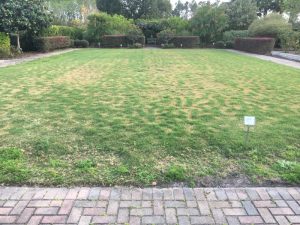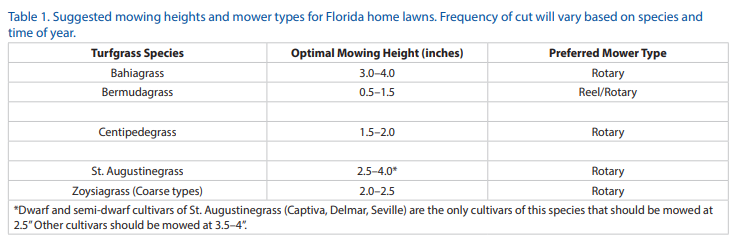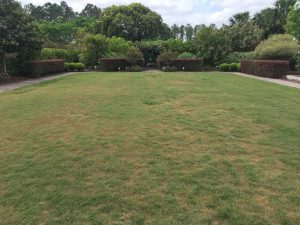How would you describe this pattern in the turfgrass?

Leopard print, Zebra turf, swirlie, wormy, or psychedelic… The pattern described by many names looks quite interesting, almost artistic!
This unusual pattern is a result of frost damage on warm season turfgrass.
Here in Florida, you may observe this pattern in bermudagrass or zoysiagrass anytime in the cool season when temperatures drop and frost is present. Frost can occur even if the thermometer does not indicate freezing temperatures. According to the National Weather Service, air temperature is typically measured about 6 feet above ground level, and the temperature at the ground level may in fact be a bit lower! Frost will be more prevalent in open areas on a calm evening.
The unique patterns have been studied by physicists who have demonstrated that there is basically an atmosphere above the turf layer (Ackerson, et. al. 2015). The patterns seem to be a result of thermal instability and convection that occur in a dense, uniform canopy of certain turfgrass species.
Management
The swirlie grass maze is not caused by any pest or disease. If this is observed, it is truly a wonder of nature to behold! The frost pattern may occur moving into the cool season, indicating that the turf is moving into a more dormant state. The pattern may also happen late in the Winter as the turf begins coming out of hibernation.
If the leopard print turf does occur in late Winter to early Spring, your management should be aimed at letting the grass do its Spring thing, steadily greening up with longer days and warmer temperatures. Relax and give the lawn some time to recover, and then keep the mowing height high while the pattern evens out over the course of a few weeks. Once the pattern begins to dissipate, you can mow the grass back down removing only 1/3 of the blade each mow to avoid scalping the grass. Bermudagrass and Zoysiagrass do thrive a bit shorter than St. Augustinegrass or Bahiagrass, as indicated in the University of Florida document, Mowing Your Florida Lawn. You may have to increase the frequency of mowing to bring the turf back down to the proper height without scalping so that your beautiful turfgrass can continue to thrive season after season!

Local Observations
This pattern was observed on Thursday, March 5th, one day after mowing at UF/IFAS Extension Orange County in the Celebration Bermudagrass in the formal garden. The lows the evening prior were in the 60s, and the lowest temperature observed was on January 22, 2020 reading about 36 degrees F. It seems strange to talk frost in March, but the unusual nature of this turfgrass anomaly could be observed moving into or out of the cool season.
Patience, wonder, and proper mowing practices will get your grass back to beautiful in no time!
Resources
Ackerson, Bruce J., et al. “Ground Level Air Convection Produces Frost Damage Patterns in Turfgrass.” International Journal of Biometeorology, vol. 59, no. 11, 2015, pp. 1655–1665., doi:10.1007/s00484-015-0972-3.
https://www.weather.gov/abr/frost_fall2012
https://edis.ifas.ufl.edu/pdffiles/LH/LH02800.pdf
https://ext.vt.edu/lawn-garden/turfandgardentips/tips/Frost_damage.html
https://gardeningsolutions.ifas.ufl.edu/lawns/problems-and-solutions/cold-damage-to-turf.html
https://gardeningsolutions.ifas.ufl.edu/lawns/lawn-care/how-to-help-your-lawn-survive-the-chill.html
Thank you to Dr. Bryan Unruh, Professor of Environmental Horticulture at the University of Florida for expert guidance!
 1
1


